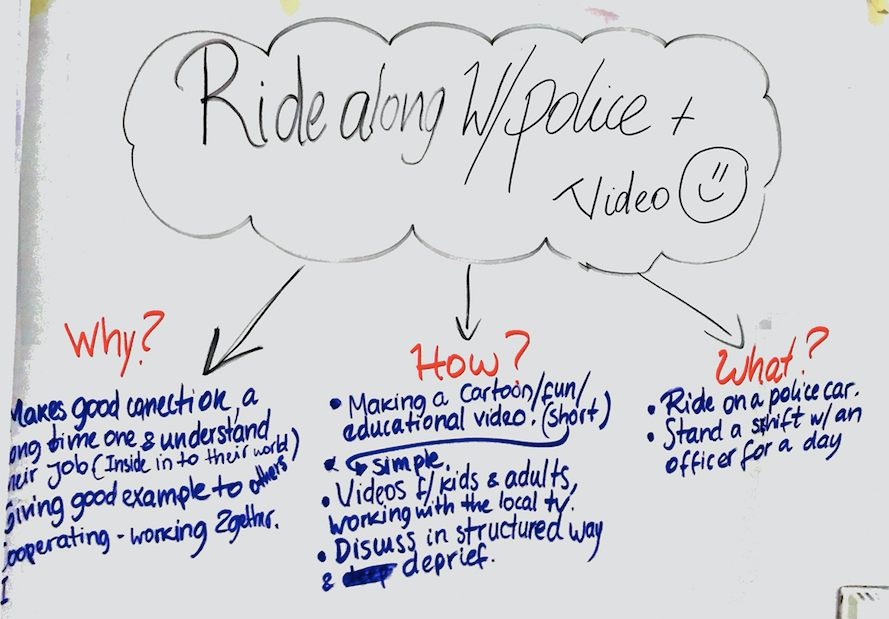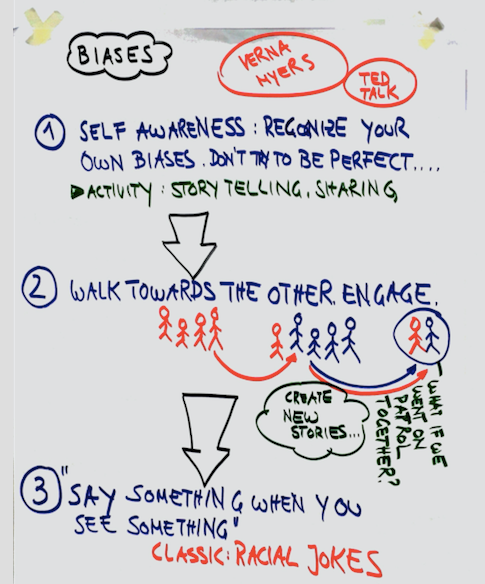The Practice of Collaboration 5: Facing our biases and walking towards them
Purpose of the Exercise: Facing our biases and walking towards them
The purpose of this exercise is for individuals and groups to recognize that they have biases but instead of feeling guilty, find ways to do something about them. The exercise also invites participants to deal with situations where biases are expressed openly, a racial joke is told, etc.
Step by Step Instructions
Put together a group of people ideally consisting of participants who may have biases against each other and that is diverse (Examples: Police and immigrants, staff of a bank and an NGO, etc.). Ideally, invite the group to watch the Verna Myers TED Talk mentioned above before the workshop.
Introduce the session e.g. by using the ecloo Difference Card and explain how – for many people – differences are a threat. You may also mention that probably everyone has biases and give an example: I have a bias against police and typically when I see a police officer, I’d rather walk away than towards him or her even though thanks to the Reykjavik project, this has improved a little for me 🙂. The way you introduce this is important in the sense that you show that you take bias seriously yet without drowning in guilt but ready to do something about it.
- After your short introduction, ask your participants to form pairs or groups of three and ask them to share one bias. Give them 5 minutes to discuss in those small groups.
- Then ask all participants to get up and answer a series of questions: Participants answer YES by moving to your left, they answer NO by moving to your right.
- Do you have a bias? (if yes, participants move to your left, if no, they move to your right. It is possible that some people think that they do not have any bias but probably not many. If that is the case, you may ask them about a bias they had in the past and managed to overcome). Ask people on both sides to tell a story or an insight related to a bias they have.
- Is there a bias you have managed to overcome in the past? Again, participants move to the left if YES, to the right if NO. Debrief by asking for some examples.
- Do you have a bias that you secretly “cherish” and find particularly hard to overcome? Ask again for some stories from participants.
- Then ask participants how hard they find it to get rid of their bias on a scale from 1 to 10. Ask participants to stand on an imaginary line of 1 to 10. Encourage them to talk among themselves, then ask for some examples from the bottom of the scale to the top.
- By now, your participants will probably have a good understanding what bias means, how it is relevant to them and how challenging it is to get rid of biases. This leads to the question: What can you do about your bias? Verna Myers suggests to walk towards your bias. In this next step, I suggest you do that by not “only” meeting the group against which you might have a bias but doing something together. Here are the instructions for the group: Work again in pairs or groups of three and discuss discuss the following questions:
- How might I get in contact with a group against whom I have a bias? Ideally, it would be a person in the room representing that group.
- What activities might we design together to enable us to get to know each other better? Examples from the police and immigrant projects: Immigrants ride along with the police, Immigrants help design the curriculum of the Police Academy, Immigrants and Police Officers play in a soccer tournament like in the French project (see this article in LeMonde in French), etc.
- It is important that after the contact and activity have taken place there is a chance to debrief the experience. This would probably need to be done in a separate workshop.

Ride Along for Immigrants with the Police as a means to create empathy in both directions. Poster created by police and immigrants in Reykjavik.
Verna Myers also talks about an important additional step: What do you do when you are in a family gathering and someone makes a joke based on bias? Do you say something or you just pretend that you did not hear and go over the awkward silence? Of course, it is important to say something especially with children at the table. But how? Non Violent Communication may be one way of doing it. It will be presented in a separate blog post and exercise.
Applying this in Your Organization
You can run such exercises with any groups in your company or organization. The more diverse the group, the better as it will create more engagement and more opportunities for action and reflection around bias.
Help for Facilitators
Some people in the company or organization may not feel safe talking about their own biases, this is why it is important to create a safe space where e.g. supervisors talk about their biases first (brief them accordingly before the workshop about why this is important). Also, create small groups for people to talk about their biases. When discussing things in plenary, do not force people to speak up. Ideally, such a workshop takes place in a cross sector collaboration setting where people may not know each other and come from different organizations and companies.
Also, when thinking of bias, do not limit the concept to culture or ethnicity even though this is where bias often becomes most obvious. Bias can also play a role in a company between different departments e.g. finance and marketing.
Last point: Make sure you offer an opportunity for participants to debrief their experience of encountering the “other” in a separate session. It is not enough to encounter the “other”, it is important provide an opportunity for structured reflection.


